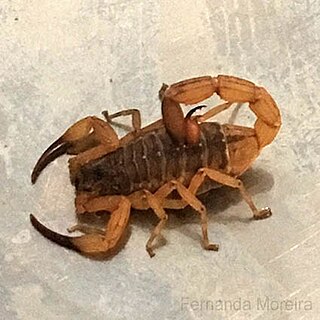 W
WCalliaster elegans is a species of starfish in the genus Calliaster.
 W
WDoratogonus is a genus of millipedes in family Spirostreptidae. They are relatively large, at 80–200 millimetres (3–8 in) long, relatively common, and distributed across Southern Africa. Many of the species are listed on the IUCN Red List due to habitat destruction.
 W
WGonatotrichus minutus is a species of millipede in the family Siphonophoridae, described in 1922 by the Swiss zoologist Johann Carl. The species is endemic to Malaysia. Individuals are very small, around 5 millimetres (0.20 in) long and, 0.7 mm wide, with around 40 body segments. The color is brownish-yellow, with lighter-colored legs. It differs from other Malaysian siphonophorids by its small size, the aspect ratio of its beak and antennae and the shape of the front gonopods.
 W
WGosodesmus claremontus is a species of platydesmidan millipede, described by Ralph V. Chamberlin in 1922, that is widely distributed in the U.S. state of California. Individuals vary in color from bright pink to coral, and may possess a black or purple dorsal stripe. Body length ranges from 17 to 27 mm, with up to 81 body segments. Gosodesmus occurs on the Coast Ranges as well as the Sierra Nevada, and is often found within rotted wood, especially oaks.
 W
WLimnatis nilotica is a species of leech in the family Hirudinidae. It is hematophagous, living on the mucous membranes of mammals.
 W
WNomura's jellyfish is a very large rhizostome jellyfish, in the same size class as the lion's mane jellyfish, the largest cnidarian in the world. It is edible but not considered high quality. It is the only species in the monotypic genus Nemopilema.
 W
WStenochrus portoricensis is a species of short-tailed whipscorpion in the family Hubbardiidae. They are mostly found in North and Central America, but their parthenogenetic lifestyle allows them to live in other parts of the world in temperate climates.They are able to thrive in different parts of the world, especially in caves, forests, fallen logs, and abandoned nests of termites.
 W
WTityus serrulatus, the Brazilian yellow scorpion, is a species of scorpion of the family Buthidae. It is native to Brazil, and its venom is extremely toxic. It's the most dangerous scorpion in South America and responsible by the most fatal cases.
 W
WUrticina columbiana, common names crusty red anemone, Columbia sand anemone, sand anemone, and the sand-rose anemone, is a species of sea anemone in the family Actiniidae.